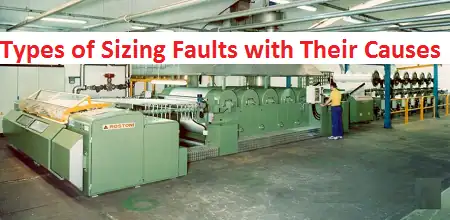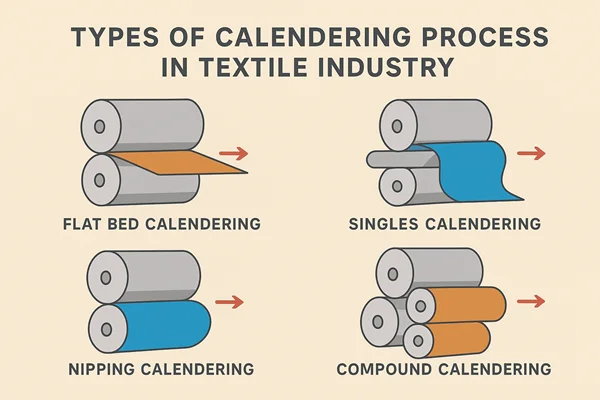Types of Sizing Faults and Their Causes in Weaving Process
Before woven fabric manufacturing, warp yarns are sized by using different processes which totally depends on the required quality of yarn or fabric. Sizing is the process of applying size ingredients in the warp yarn. After applying the sizing process in warp yarn, different types of changes occurred such as increased frictional resistance, flexibility, smoothness, etc. During this process, several defects are produced which are deeply discussed in this article. Here we are presenting Types of Sizing Faults and Their Causes in the Weaving Process.

Types of Sizing:
The sizing process is classified into three types, which are pointed out in the below:
- Pure sizing,
- Light sizing,
- Medium sizing,
- Heavy sizing.
All the above types of sizing are explained in the following:
- Pure Sizing: This type of sizing process is used to produce unbleached fabric. In the case of pure sizing, up to 10% of size ingredients are used in warp yarn.
- Light Sizing: Light sizing is used for printing and dyeing. In the case of light sizing, 11-15% of size ingredients are used in warp yarn.
- Medium sizing: In the case of medium sizing, 16-40% size ingredients are used in warp yarn.
- Heavy sizing: During heavy sizing, more than 40% size ingredients are used in warp yarn.
Properties of Size Ingredients:
Important properties of size ingredients are-
- Ingredients should not cause any degradation of the textile materials.
- It should provide excellent fabric properties.
- It should be coherent with the sizing machinery and its associated parts.
- It should not change the color of colored yarn of colored shade.
- It will be that which imparts the least exfoliation.
- It should be easily removed during the wet processing process.
- The adhesive substance must be more adhesive.
- Sizing ingredients should not cause any kind of health hazard.
- These ingredients should be always natural.
- It should not do any harm to the yarn or fiber.
- Sizing ingredients should be always cheap.
- These kinds of ingredients should be available here and there.
- The sizing recipe must be that which provides lower-end breakages.
- These kinds of ingredients must be easily washable which means it imparts easy de-sizing.
- These kinds of ingredients should have the ability to dry instantly after completing the sizing process.
Techniques of Sizing Process in Weaving:
There are different techniques of sizing process followed in weaving factories which are mentioned below:
- Combined sizing,
- High-pressure sizing,
- Foam sizing,
- Solvent sizing,
- Electrostatic sizing,
- Emulsion sizing,
- Conventional sizing,
- Hot melt sizing.
All the above sizing techniques are explained in the following:
1. Combined sizing: Combined sizing is used for sizing denim. This type of sizing is done by using two different processes. At first, the warp yarn is dyed and then sizing is done.
2. High-pressure sizing: This type of sizing process is done by applying high pressure to impart size solution penetration into warp yarn. It should be noted here that, the take-up percentage is less but drying is faster. The cost of high-pressure sizing is high.
3. Foam sizing: In the case of foam sizing, the foaming agent is added to the size solution. After that, the produced foam is applied to the warp yarn. The foam sizing process is used for achieving light shade and higher-quality yarn.
4. Solvent sizing: In solvent sizing, various types of organic solvents is used without water. The machine which is used here has a hood to protect the evaporating of solvent. As a result, solvent loss will be very low here and solvent can be used once again. This process is very economical.
5. Electrostatic sizing: It is a very costly process in sizing. This process is done by applying electrostatic force.
6. Emulsion sizing: In the case of emulsion sizing, size ingredients have passed through the emulsion. Here, emulsion is prepared with oil polymer and soap which are brought into emulsion form.
7. Hot melt sizing: In the hot melt sizing process, size ingredients are prepared in the form of a solid or block which is placed over a grooved cylinder. Sizing materials melt when the cylinder is heated.
Types of Sizing Faults and Their Causes
There are different types of sizing faults that arise in the sizing process of weaving machines technology, which are pointed out below:
- Uneven sizing,
- Hard sizing,
- Sandy warp,
- Size spots,
- Shinnery,
- Size dropping,
- Ridge beam,
- Improper drying,
- Size stitching,
- Repeating warp streaks.
All the above sizing faults are explained in the following:
1. Uneven Sizing:
Causes of Uneven Sizing:
- It arises due to or under or over sizing process,
- It arises because of under or over-concentration of size liquor.
2. Hard Sizing:
Causes of Hard sizing:
When sizing ingredients are applied too much in the warp yarn the size becomes too much hard which ultimately causes of hard sizing.
3. Sandy Warp:
Causes of Sandy Warp:
This type of fault produced due to grinding or crushing the size material perfectly.
4. Size Spots:
Causes of Size Spots:
During the sizing process in warp yarn, size ingredients must be added gradually into the chemical mixing tank for perfect mixing of chemicals. It if it’s not happened there, then this type of fault is produced.
5. Shinnery:
Causes of Shinnery:
This type of defect is produced because of the friction between the drying cylinder and warp yarn.
6. Size Dropping:
Cause of Size Dropping:
These types of defects should be removed as soon as possible which is produced due to not optimum the viscosity of the sizing solution.
7. Ridge Beam:
Causes of Ridge Beam:
Ridge beam faults of sizing is produced due to unequal distribution of yarn wraith during the sizing process.
8. Improper Drying:
Causes of Improper Drying:
Here, in case of over-drying, hard sizing defects are produced, and in case of over-drying, bacteria formed. As a result, yarn breakage occurred here.
9. Size Stitching:
Causes of Size Stitching:
When drying is not perfect after completing the sizing process, then this type of fault is produced.
10. Repeating Warp Streaks:
Causes of Repeating Warp Streaks:
Repeating warp streak defects are produced because of improper tension in the pre-beam.



